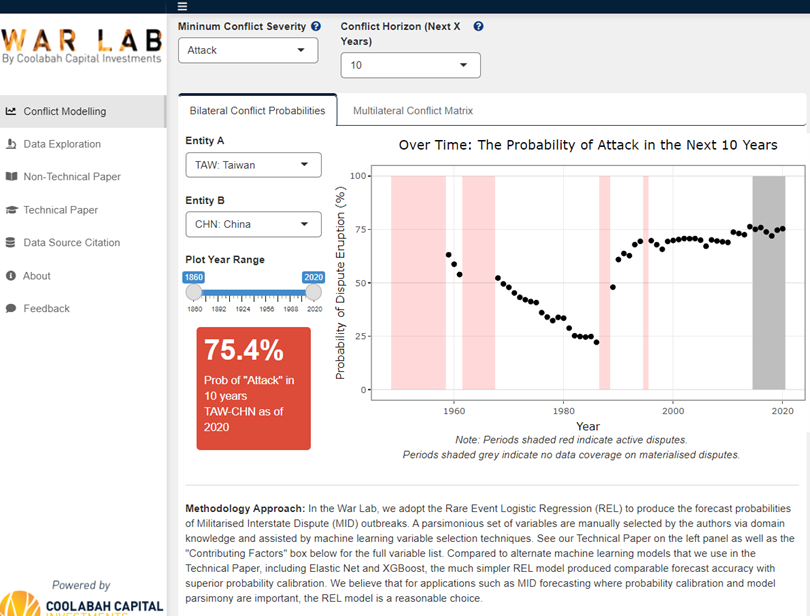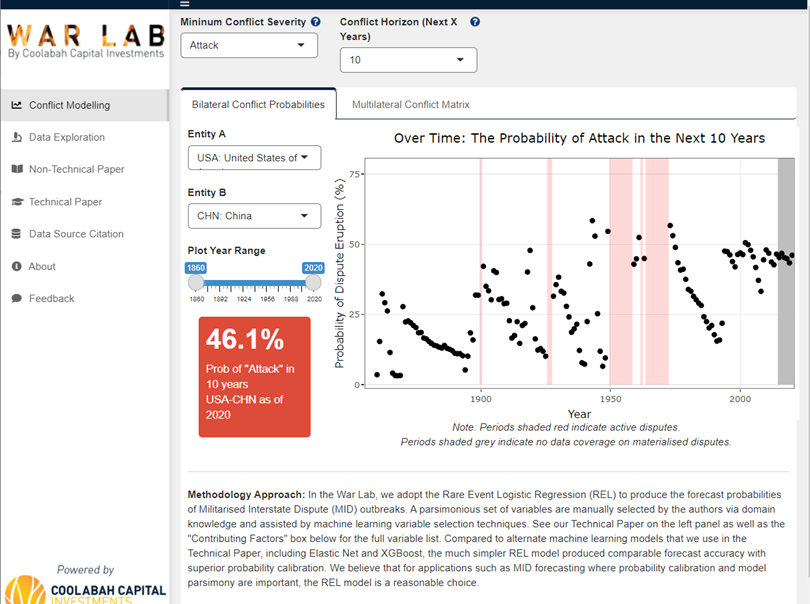Modelling puts China and US conflict risks at almost 50pc
In the AFR I write that back in 2012 this column argued that notwithstanding a wealth of data on the history of military conflicts, and the so-called “correlates of war”, there was a staggering paucity of serious quantitative research on the actual empirical probability, or risk, of these existential events materialising.
There was a further absence of efforts to rigorously predict conflicts between specific country pairs leveraging the extraordinary array of longitudinal information that we can now access, which affords potentially powerful insights into the shifting probabilities of nations engaging in warfare.
This column observed that although “the most profound hazard face is the risk of war… we invest vast taxpayer resources nominally insuring against it… there is a startling dearth of quantitative research on forecasting the frequency and severity of wars… despite more than 200 conflicts since 1900, causing 35 million deaths.”
In a 2012 paper, the Swiss professor Thomas Chadefaux similarly noted that, “the prediction of war has been the subject of surprisingly little interest in the literature, in marked difference to a wide range of fields, from finance to geology, which devote much of their attention to the prediction of extraordinary – black swan – events such as financial crises or earthquakes”.
After advocating for the development of conflict forecasting models (including via a piece published by the Lowy Institute), a researcher from the Department of Defence made an approach to discuss the proposal, suggesting that the military was interested in pursuing it. But nothing eventuated.
As an investor in global financial markets with a team of 30 professionals, including 11 quantitative specialists, five of whom have PhDs in maths, physics, computer science and engineering, we are constantly grappling with the prediction business. Last year, for example, we developed COVID-19 forecasting models for every country globally that allowed us to anticipate an earlier-than-expected peak in the first wave of infections in April 2020.
For the past decade the single-biggest macro event risk that we have been seeking to understand is the spectre of war between the two dominant super-powers, the United States and China. Intuitively, the probabilities of a US-China conflict erupting appear to have accelerated under the hard-line presidency of Xi Jinping with many experts, including Dr John Lee, Dr Oriana Skylar Mastro, Dr Rory Medcalf and Dr Ross Babbage, now handicapping the risk of a lower-intensity conflict at circa 50 per cent, if not higher (note all these individuals consult to us).
This week we revealed via the Australian Strategic Policy Institute, a defence think-tank, that a team led by Kai Lin, Nathan Giang, James Yang and myself have been working on research that draws on 160 years of academic conflict data to develop advanced quantitative techniques, including the latest machine learning methods, to predict the empirical probability of different types of military conflicts (with varying severities) over a range of forecast intervals, focussing on horizons of 12 months, 5 years, and 10 years. This research, which covers most countries, is summarised in a technical academic paper and a companion non-technical summary, which are now publicly available.
Cases of military acts by one nation-state directed explicitly towards the government, official representatives, official forces, property, and/or territory of another state are known in the academic literature as “militarised interstate disputes” (or MIDs). MIDs can be classified into increasing tiers of severity, ranging from a threat to use force (“threat”), the actual use of force (“force”), an attack, clash or raid (“attack”), or all-out war with a minimum duration and number of battle deaths (“war”). We utilise these definitions in our forecasting models.
To tackle the relatively rare-event forecast problem that warfare represents, we applied a representative suite of data science, statistical, and machine learning techniques to an array of data sets on potential variables that explain MIDs, with the modelling approaches assessed on their ability to generate accurate and calibrated probabilities of future outbreaks of MIDs between nations.
Significantly, our research currently implies that the probability of a low-intensity kinetic military conflict between Taiwan and China over the next 10 years has trended higher over time towards approximately 75 per cent today. Accounting for global alliance networks, the probability of a low-intensity military conflict over the next decade between the United States and China is also elevated at around 46 per cent. Other country pairs likewise face seemingly high probabilities of low-intensity conflict, including the United States and Russia (30 per cent), China and Russia (44 per cent), China and Japan (46 per cent), and China and India (55 per cent).


When we raise the conflict intensity threshold from smaller-scale “attacks” to outright “war”, the conflict probabilities decline noticeably, although they remain material. Our modelling suggests, for instance, that country pairs including China and India (22 per cent), China and the US (12 per cent), China and Taiwan (11 per cent), and China and Japan (10 per cent) all have a one-in-ten to one-in-five chance of engaging in a bona fide war in the next 10 years with potentially cataclysmic consequences. (The risk of war between the United States and Russia is, interestingly, much lower at 2 per cent).
These models and their calibrated probabilities have a wide spectrum of potential applications, including military strategic planning, government foreign policy making, political decisioning, and financial risk management. In covering this research, The Australian newspaper’s foreign editor Greg Sheridan argues that while “there is no risk more important than a potential US-China conflict… most analysis of such issues is necessarily impressionistic and subjective”.
Beyond better understanding the threats we face, disclosing the real empirical probability of conflict could help decision-makers mitigate the tendency of the community to under-value defence spending—and the catastrophe insurance it provides—by extrapolating out from their own peaceful existence.
“This research indicates that every active player should be hedging conflict risk during the next five to 10 years especially,” Sheridan concludes. In a Sky News interview with Peta Credlin on the modelling, Sheridan points out that this is precisely why Australia’s inability to properly defend itself with credible asymmetric military capabilities is so inherently problematic.
To the best of our knowledge, the core contribution of this work to the academic literature is the integration of a wide range of historical data sets, including predictors of MIDs and advanced variable selection methods, with sophisticated modelling techniques to address a well-defined set of forecasting problems based on differing MID severities and time horizons, culminating in the generation of calibrated forecast probabilities of different types of MID outbreaks between any state pair of interest. We believe this is also the first time these insights and forecast probabilities have been disseminated via a publicly accessible graphical user interface system.

Our goal is to stimulate further academic study and inject greater objectivity into public debates around the risks of military conflicts, which are almost always predicated on qualitative and highly subjective opinions that are frequently devoid of a data-centric, evidentiary basis and lack empirical testing of their efficacy.
To further facilitate discussion and education around the risks of conflicts, we have developed an interactive graphical user interface that is available at (VIEW LINK). This houses one of our simpler, logistic regression forecasting models and also provides data visualisations of the changing historical conflict probabilities between individual countries and animations of the shifts in national military capabilities over hundreds of years.
On the topic of existential conflict, our perspicacious premier, Dominic Perrottet, sought to set the record straight in response to this column’s characterisation of his role as a right winger (successfully) battling shadow treasurer Daniel Mookhey’s western suburbs mates on Redfield College’s “manicured” lawns.
“I am compelled to correct some egregious assertions made by your columnist Christopher Joye and the shadow treasurer on the important topic of high school footy,” Perrottet wrote in this newspaper’s letters page.
“Contrary to your reporting, the “manicured lawns” of my school circa 1995 were comprised of two glorified paddocks in Sydney’s outer north-west, laid out next to the shipping-container demountables that served as classrooms, and next door to an old chicken farm.”
“Part of footy training was removing rocks from the hard clay beneath the lumpy covering of buffalo on the paddocks. As for coaches, they were mostly dads knocking off work early, vicariously living out their dreams through their sons. And with barely 30 people in my entire grade, we had to resort to soccer players – yes, soccer players! – to make up the numbers.”
Displaying some of the “swagger” that Mookhey recalls Perrottet portrayed back in the day, the premier says “I’m pleased to confirm our victories over the shadow treasurer’s team were then (as now) emphatic.” “We smashed them.”
The indomitable Mookhey retorts that “while they might have won the matches because of better coaches, training, and equipment, we definitely won the fights”.
Perrottet concludes with an interesting concession to his former moderate rivals, including new NSW Treasurer Matt Kean: “while I often started on the right wing, I scored most of my points in the centres”. “Make of that what you will.” Indeed.
Access Coolabah's intellectual edge
With the biggest team in investment-grade Australian fixed-income and over $8 billion in FUM, Coolabah Capital Investments publishes unique insights and research on markets and macroeconomics from around the world overlaid leveraging its 16 analysts and 5 portfolio managers. Click the ‘CONTACT’ button below to get in touch.
3 topics

